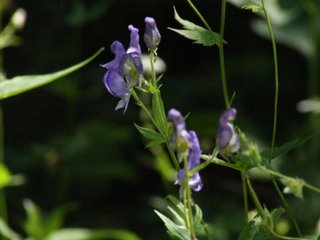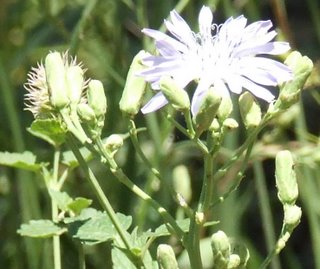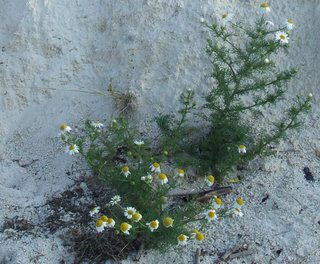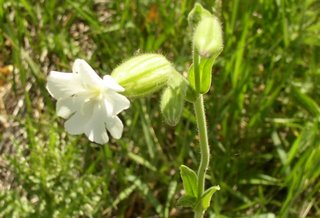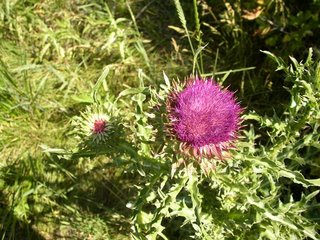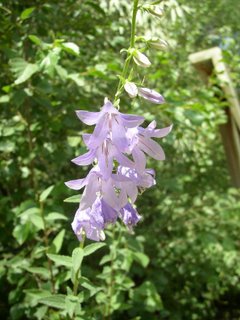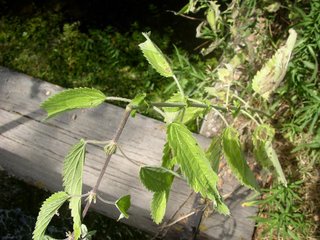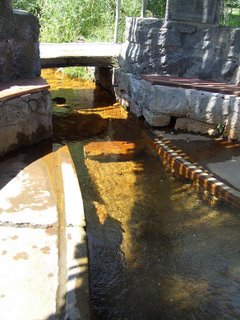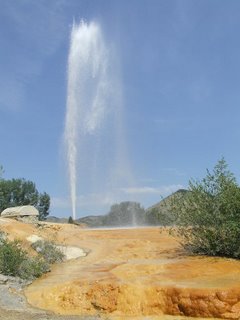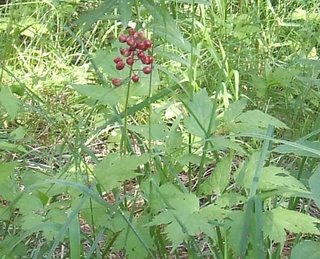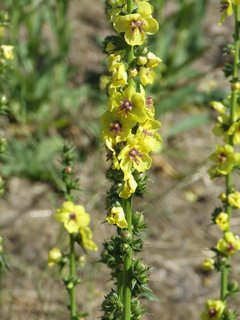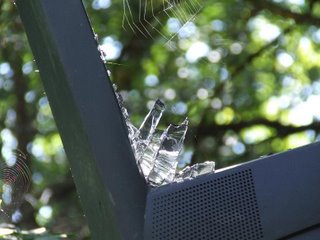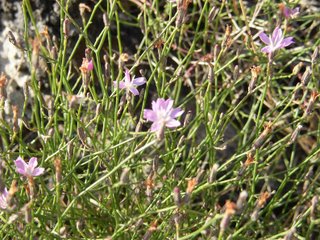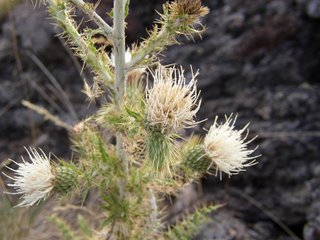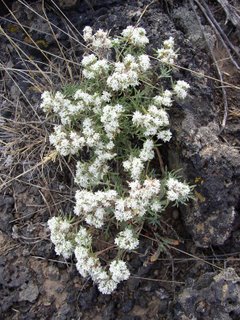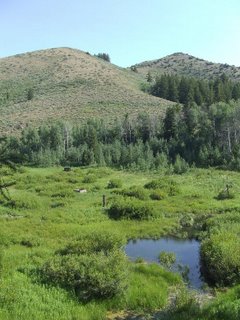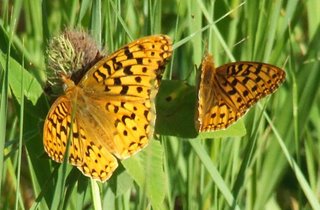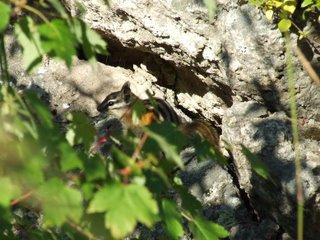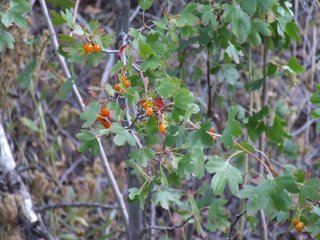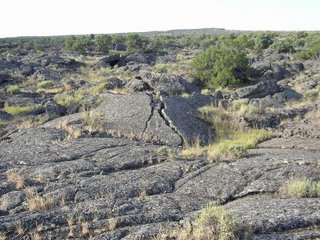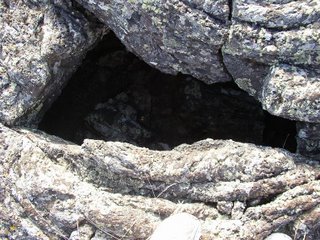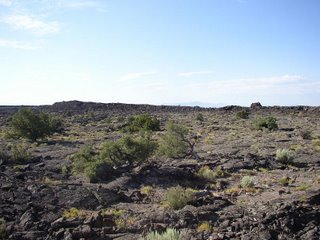Yesterday was my birthday [Thank you to those of you who acknowledged it]. I actually had my birthday present from my mom about a week early, but figured I'd wait to post about it until the actual event. It's a camera. With a 12X optical zoom. My other camera is great for scenery and flowers, but for skittish wildlife, it's a joke. You have to get waaaay too close, which can be dangerous and is nearly always impractical. So I'd been wanting one with a high optical zoom for a long time. FYI, digital zoom is NOT the same thing. Digital zoom is essentially the same thing you can do on your computer: zoom in on an existing image. The further you zoom in on it, the worse it looks. Optical zoom actually uses lenses to get you a better image of an object far away. So I can now GET decent pictures of stuff that would be barely visible at best with the other camera.
There is a trade-off, however. Basically, the old camera is near-sighted. The new one is far-sighted. With my old camera, I can get great flower shots from 6-12 inches away, occasionally closer. The new one won't focus on anything closer than six feet, unless you put it on "flower" mode [the button has a flower on it], and even then you can't zoom heavily on anything closer than six feet. The first day I tried it out, I was getting very frustrated with it, but I'm slowly getting the hang of taking decent pictures of flowers with it. It's really nice to be able to zoom in on something that I couldn't possibly get to (across a river; up a cliff; whatever) and actually see what kind of flower it is. It's just frustrating that I have to back up, and back up, and back up...if I want a picture of a flower right beside me on the path. Oh, and I DID get a few wildlife shots today. Nothing too exciting: birds and bugs, mostly. But I'm happy that you can SEE them, and tell what they are.
And the other Blackrock Canyon is between Pocatello and Inkom. It goes up towards the mountain formerly known as Chink's Peak (changed to Chinese Peak at the behest of a Japanese immigrant who found the name offensive; I found it a historical curiosity, since I've never encountered anyone who actually uses 'Chink' as a derogatory term for orientals). At any rate, I took the long way around. I'm sure there IS a shorter way to get there from where I was, but I didn't know where to turn. So I took a quite scenic and interesting route through the back hills between Pocatello and Inkom. Some very pretty country there, and a place where my mom might be able to acquire some cattails. I don't know why she wants them; just that she continually brings them up. Anyway, after I was thoroughly confused as to my location relative to the rest of Idaho, I consulted a map...and found that I might as well keep on the same road (but turn around) and go to Inkom, and then the place I wanted would be off Highway 91.
From the looks of things, the trail is mostly used by ATVs, though I encountered none today. I walked up it until it joined another ATV trail, and picked that as a good time to turn around. This is one that would be better earlier in the year, as it has very little shade. There are a few shady spots where some trees grow, but not many. Still, it was quite enjoyable. I might come back very early sometime and try it before the heat sets in.
Two events of interest. Just as I was starting out, I saw an interesting...bug. At first I thought it was a strange spider, but I finally saw that there were, in fact, three body segments. The bug itself was interesting, but more interesting was when an ant attacked it. I suppose the ant thought it might be a good snack, but this fuzzy orange bug wasn't injured and fended itself off. It or the ant made a sort of buzzing/whistling noise. Very, very faint, but it stopped when the confrontation stopped. As far as I know, ants don't make noise, so I'll assume it was the orange bug, telling the ant off. Here's the orange bug (old camera):

The other also involved a confrontation, but between a hawk and a vulture. *grins* I'd been hearing hawk cries (the sort of kree-ee-aahh), but when I'd looked up, I'd only seen the vulture. Finally I saw them both. At first, it looked like they were both just circling in the air, maybe even working together. Then the hawk divebombed the vulture. She kept doing this every time the wind currents brought her on a trajectory toward the vulture, and the vulture kept flapping to get out of her way. And I'm not sure why I think the hawk was female. Anyway, I just stopped where I was on the hillside and watched the show for a while, until they both disappeared over the next hill. It looked like maybe the vulture was following the hawk, hoping she'd lead him to a food source. *shrugs* Anyway, I didn't get the vulture, but I DID get a picture of the hawk (new camera; with the old, she would have been an itty bitty speck):

I did crop the image down, as she was surrounded by an awful lot of blue sky. :^D {Update: I'm reasonably certain this is a red-tailed hawk. The plumage can vary, but the call is quite distinctive.}
And I'll finish off with a few shots made possible by my new toy:
 Bluebird. {UPDATE: Probably a Lazuli Bunting instead, Passerina amoena. They have more rounded bills and less red on their chests. I can't be certain without a shot of the wings, though. Lazuli bunting's have light stripes on their wings.} I couldn't tell that it was blue when I was taking the picture, though. All I could see was that the head was darker than the body.
Bluebird. {UPDATE: Probably a Lazuli Bunting instead, Passerina amoena. They have more rounded bills and less red on their chests. I can't be certain without a shot of the wings, though. Lazuli bunting's have light stripes on their wings.} I couldn't tell that it was blue when I was taking the picture, though. All I could see was that the head was darker than the body.
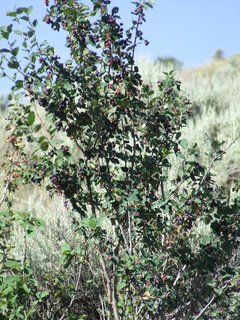 A bush full of berries on the hillside. It was far enough up and off the trail that I didn't want to climb to get a better look. With the close-up, though, I'm pretty sure this is a blueberry bush. (There were also currant bushes, with ripe currants, but I didn't take pictures of them)
A bush full of berries on the hillside. It was far enough up and off the trail that I didn't want to climb to get a better look. With the close-up, though, I'm pretty sure this is a blueberry bush. (There were also currant bushes, with ripe currants, but I didn't take pictures of them)
 I've gotten pictures of similar butterflies before, but because this was all optical zoom, the detail is SO much better. You can almost see the scaling on the wings! And this one is Weidemeyer's Admiral, Limenitis weidemeyerii. I'd never seen these before this summer, but they seem to be pretty common in the hills around here. They feed on aspens, willows and cottonwoods.
I've gotten pictures of similar butterflies before, but because this was all optical zoom, the detail is SO much better. You can almost see the scaling on the wings! And this one is Weidemeyer's Admiral, Limenitis weidemeyerii. I'd never seen these before this summer, but they seem to be pretty common in the hills around here. They feed on aspens, willows and cottonwoods.
 One nice feature of the new camera is a "rapidfire" mode, where it will continue to take pictures so long as you keep holding down the button. These little butterflies moved around so much that it was really the only way to get a decent picture of them. Not as distinctive as the Admiral above, but it's probably a Cabbage White, Pieris rapae. The two spots mean it's female (male has only one spot).
One nice feature of the new camera is a "rapidfire" mode, where it will continue to take pictures so long as you keep holding down the button. These little butterflies moved around so much that it was really the only way to get a decent picture of them. Not as distinctive as the Admiral above, but it's probably a Cabbage White, Pieris rapae. The two spots mean it's female (male has only one spot).
 And this butterfly seems to be a Small Wood-Nymph, Cercyonis oetus. They feed on grasses, and are often abundant in sagebrush scrub.
And this butterfly seems to be a Small Wood-Nymph, Cercyonis oetus. They feed on grasses, and are often abundant in sagebrush scrub.
 *sighs* This one didn't focus as well as the others. I needed to either take a step back or zoom out a bit. I think this is some sort of Fritillary. Closest match I've got is Hydaspe Fritillary, Speyeria hydaspe. The odd thing is that both Fritillaries prefer moist areas. There were a few mudholes in the road (late snow melt?), but otherwise it was quite dry.
*sighs* This one didn't focus as well as the others. I needed to either take a step back or zoom out a bit. I think this is some sort of Fritillary. Closest match I've got is Hydaspe Fritillary, Speyeria hydaspe. The odd thing is that both Fritillaries prefer moist areas. There were a few mudholes in the road (late snow melt?), but otherwise it was quite dry.
I do have a few new flowers to find, from this trip and from Hell's Half Acre, but those will wait a bit. I just wanted to show off what my new camera can do. Oh, and butterfly identifications are all from National Audobon Society: Field Guide to the Rocky Mountain States. It's my only book with butterflies in it.
Inquire Further
Relinquish






